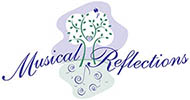Tami Briggs has a certification in harp therapy from the International Harp Therapy Program. In these videos, she briefly introduces and demonstrates harp therapy.
Virtual Bedside Vigils:
Since the CoVid pandemic, Tami Briggs started providing virtual harp therapy bedside vigils via Zoom.
While the harp’s vibrations are stronger in person, Tami shares the benefits of harp therapy are also possible virtually, including:
- Creates a calming environment in homes and for hospital/hospice patients, families, visitors and staff.
- Allows hospital patients and families to focus on something hopeful and beautiful to distract them from pain and suffering.
- Nurtures people in time of physical and/or emotional pain.
- Provides positive sensory stimulation.
- Improves physiological effects, such as relaxed muscle tension, increased oxygenation, slower heart rate, lowered blood pressure, etc.
- Provides palliative care for hospital and hospice patients in transition.
Scheduling and Payment:
Tami lives in Minneapolis, MN; to schedule a Zoom session, contact her at 952-829-1919 or ta**@****************ns.com. Suggested donation is $75 per session with sessions ranging from 45 to 60 minutes. We are also aware that CoVid created a hardship for many people and Tami doesn’t want the fee to be a deterrent from playing for your loved one(s). For payment options for your loved one or to provide a scholarship for a bedside vigil, click here.
The Healing Tradition of the Harp . . .
The harp is steeped in healing tradition. The characteristics that make the harp unique for healing include:
- The instrument’s archetypal significance as an ancient, spiritual healing instrument, which opens doors to the collective unconscious and, therefore, may facilitate the healing process.
- Its wide pitch range (low C-32.703 Hz to high G-3136.0 Hz), which can vibrate the entire body.
- Its varied and soothing palette of tone colors.
- The ethereal effect created through the harp’s unique glissando technique (utilizing enharmonic tones).
- The tension release associated with the emotional expression of plucking its strings, as Pythagoras suggested when he saw the strings as symbols of the nervous system.
- The instrument’s vibratory effect on the harpist’s body, especially the thymus gland, a major gland of the immune system located in the chest.
–Excerpted from the Spring ’96 Harp Therapy Journal
Laurie Riley, founder of the Music for Healing and Transition Program, said in the Winter ’98-99 Harp Therapy Journal, “The harp, with its many strings, consistently generates a profound response in the listener. For example, a very experienced keyboardist (and music practitioner) began harp studies, and after a few months, played in the hospital she was working in. The nurses’ response to the harp was more accepting than to any of her previous work with the keyboard, and they increased her access to more patients. There are many effective instruments, but the harp seems to be the epitome of a healing instrument.”
Fabien Maman, French composer and musician, says in the Summer ’98 Harp Therapy Journal, “When natural acoustic instruments are played, their sound resonates with the corresponding element and organ in the body. Stringed instruments, for example, correspond to the energy of the heart, small intestine, pericardium, and Triple Warmer meridians. The fundamental note played on an acoustic instrument nurtures the physical body, while the overtones resonant in the subtle bodies.
The plucked harp strings spread the sound — it surrounds the listener. The harp vibrates through the wood and the listener. It is a very feminine instrument and touches the heart. Healing occurs when you open the heart and solar plexus and allow the fire energy to flow — an alchemical process takes place. Other stringed instruments are more directional and restricted in their range.”

Comments from Clients . . .
“After I attended your event last night, I realized driving home that the knot in my back shoulder area had stopped being painful. Also, my neck which was tight at starting time was not stiff and did not hurt by the time the concert was finished.”
“Of all the harpists I heard this year on healing and transition, you resonate with me the most.”
“I want to thank you for your excellent presentation. I enjoyed it thoroughly and took lots of notes. What impresses me so much about your work is the importance of the ministry you practice. You are literally a ‘gatekeeper’ in so many cases, assisting with birth and death, and everything traumatic in between. I really appreciate your enthusiasm for encouraging and teaching others about harp therapy. It seems as though more and more people are yearning to do something meaningful like this in their lives, even as unpaid volunteers. It is heartwarming to see.”

Tami’s Beautiful Pedal Harp . . .
My musical journey began at age eight when I started taking piano lessons from Mrs. Willalee P. McKee. Mrs. McKee was a remarkable musician and shared her love of music with students who were willing to practice. I loved playing the piano and worked hard for her. A special bond formed between us.
Mrs. McKee was also a painter of beautiful landscapes. One day, my mother and I visited her home to purchase a painting. In the quest to find the right one, we entered the living room. There stood an immense gold pedal harp, the first harp I had ever seen. Mrs. McKee played an enchanting melody for us, thereby “planting the seed.” Someday I too would play the harp.
After just five years of lessons, my beloved piano teacher and I had a heartbreaking parting when Mrs. McKee moved from rural Missouri to Colorado. I eventually moved to Minnesota. On my thirtieth birthday, I gave myself a gift I had long wanted — harp lessons. My affinity for this instrument was present from the beginning.
I completed three recordings on a folk harp (a smaller version of the pedal harp). After each recording was published, I sent a copy to Mrs. McKee. I enjoyed sharing my progress on the instrument we both loved the most!
I longed to own a pedal harp like the gorgeous instrument I had seen in Mrs. McKee’s living room. On November 26, 1995, I wrote to her asking if she would ever be interested in selling her harp. Two weeks later, her daughter telephoned me. Mrs. McKee had died the day I wrote my letter, and the letter I wrote was forwarded to her daughter. “You were my mom’s favorite,” she told me. “I’m sure she wants you to own the harp.”
Two months after Mrs. McKee’s death, her beautiful instrument arrived at my door. Mrs. McKee is no longer on earth, but her spirit and presence grace my living room and playing every day. A beautiful gift . . . a musical and loving journey.
Tami’s harp is a Lyon & Healy Gold Style 23. Photograph by permission Lyon & Healy.

